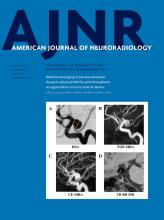Research ArticlePediatrics
Open Access
Radiologic and Pathologic Features of the Transmantle Sign in Focal Cortical Dysplasia: The T1 Signal Is Useful for Differentiating Subtypes
Yukio Kimura, A. Shioya, Y. Saito, Y. Oitani, Y. Shigemoto, E. Morimoto, F. Suzuki, N. Ikegaya, Yuiko Kimura, K. Iijima, Y. Takayama, M. Iwasaki, M. Sasaki and N. Sato
American Journal of Neuroradiology June 2019, 40 (6) 1060-1066; DOI: https://doi.org/10.3174/ajnr.A6067
Yukio Kimura
aFrom the Department of Radiology (Yukio K., Y. Shigemoto, E.M., F.S., N.S.), National Center Hospital, National Center of Neurology and Psychiatry, Kodaira, Tokyo, Japan
A. Shioya
bDepartments of Pathology and Laboratory Medicine (A.S., Y. Saito)
eDepartment of Neurology (A.S.), Mito Kyodo General Hospital, University of Tsukuba, Tsukuba, Ibaraki, Japan
Y. Saito
bDepartments of Pathology and Laboratory Medicine (A.S., Y. Saito)
Y. Oitani
cChild Neurology (Y.O., M.S.)
fDepartment of Pediatrics (Y.O.), Tokyo Women's Medical University Medical Center East, Tokyo, Japan
Y. Shigemoto
aFrom the Department of Radiology (Yukio K., Y. Shigemoto, E.M., F.S., N.S.), National Center Hospital, National Center of Neurology and Psychiatry, Kodaira, Tokyo, Japan
E. Morimoto
aFrom the Department of Radiology (Yukio K., Y. Shigemoto, E.M., F.S., N.S.), National Center Hospital, National Center of Neurology and Psychiatry, Kodaira, Tokyo, Japan
F. Suzuki
aFrom the Department of Radiology (Yukio K., Y. Shigemoto, E.M., F.S., N.S.), National Center Hospital, National Center of Neurology and Psychiatry, Kodaira, Tokyo, Japan
N. Ikegaya
dNeurosurgery (N.I., Yuiko K., K.I., Y.T., M.I.), National Center of Neurology and Psychiatry, Kodaira, Tokyo, Japan
gDepartment of Neurosurgery (N.I.), Yokohama City University, Yokohama, Kangawa, Japan.
Yuiko Kimura
dNeurosurgery (N.I., Yuiko K., K.I., Y.T., M.I.), National Center of Neurology and Psychiatry, Kodaira, Tokyo, Japan
K. Iijima
dNeurosurgery (N.I., Yuiko K., K.I., Y.T., M.I.), National Center of Neurology and Psychiatry, Kodaira, Tokyo, Japan
Y. Takayama
dNeurosurgery (N.I., Yuiko K., K.I., Y.T., M.I.), National Center of Neurology and Psychiatry, Kodaira, Tokyo, Japan
M. Iwasaki
dNeurosurgery (N.I., Yuiko K., K.I., Y.T., M.I.), National Center of Neurology and Psychiatry, Kodaira, Tokyo, Japan
M. Sasaki
cChild Neurology (Y.O., M.S.)
N. Sato
aFrom the Department of Radiology (Yukio K., Y. Shigemoto, E.M., F.S., N.S.), National Center Hospital, National Center of Neurology and Psychiatry, Kodaira, Tokyo, Japan

REFERENCES
- 1.↵
- Colombo N,
- Tassi L,
- Deleo F, et al
- 2.↵
- Palmini A,
- Najm I,
- Avanzini G, et al
- 3.↵
- Lerner JT,
- Salamon N,
- Hauptman JS, et al
- 4.↵
- Colombo N,
- Salamon N,
- Raybaud C, et al
- 5.↵
- 6.↵
- Mühlebner A,
- Coras R,
- Kobow K, et al
- 7.↵
- 8.↵
- Kadom N,
- Trofimova A,
- Vezina GL
- 9.↵
- 10.↵
- Urbach H,
- Scheffler B,
- Heinrichsmeier T, et al
- 11.↵
- Wieser HG,
- Blume WT,
- Fish D, et al
- 12.↵
- 13.↵
- 14.↵
- 15.↵
- Marusic P,
- Najm IM,
- Ying Z, et al
- 16.↵
- 17.↵
- Boonyapisit K,
- Najm I,
- Klem G, et al
- 18.↵
- Mellerio C,
- Labeyrie MA,
- Chassoux F, et al
- 19.↵
- Eltze CM,
- Chong WK,
- Bhate S, et al
- 20.↵
- 21.↵
- 22.↵
- Berg AT,
- Vickrey BG,
- Langfitt JT, et al
- 23.↵
- Bien CG,
- Szinay M,
- Wagner J, et al
- 24.↵
- Rugg-Gunn FJ,
- Eriksson SH,
- Boulby PA, et al
- 25.↵
- 26.↵
- 27.↵
- 28.↵
- 29.↵
- Yagishita A,
- Arai N
- 30.↵
- Wolff SD,
- Balaban RS
In this issue
American Journal of Neuroradiology
Vol. 40, Issue 6
1 Jun 2019
Advertisement
Yukio Kimura, A. Shioya, Y. Saito, Y. Oitani, Y. Shigemoto, E. Morimoto, F. Suzuki, N. Ikegaya, Yuiko Kimura, K. Iijima, Y. Takayama, M. Iwasaki, M. Sasaki, N. Sato
Radiologic and Pathologic Features of the Transmantle Sign in Focal Cortical Dysplasia: The T1 Signal Is Useful for Differentiating Subtypes
American Journal of Neuroradiology Jun 2019, 40 (6) 1060-1066; DOI: 10.3174/ajnr.A6067
0 Responses
Radiologic and Pathologic Features of the Transmantle Sign in Focal Cortical Dysplasia: The T1 Signal Is Useful for Differentiating Subtypes
Yukio Kimura, A. Shioya, Y. Saito, Y. Oitani, Y. Shigemoto, E. Morimoto, F. Suzuki, N. Ikegaya, Yuiko Kimura, K. Iijima, Y. Takayama, M. Iwasaki, M. Sasaki, N. Sato
American Journal of Neuroradiology Jun 2019, 40 (6) 1060-1066; DOI: 10.3174/ajnr.A6067
Jump to section
Related Articles
Cited By...
- Focal cortical dysplasia type II-dependent maladaptive myelination in the human frontal lobe
- Long-Term Follow-up of Multinodular and Vacuolating Neuronal Tumors and Implications for Surveillance Imaging
- MR Imaging Detection of CNS Lesions in Tuberous Sclerosis Complex: The Usefulness of T1WI with Chemical Shift Selective Images
- Enhanced MR Conspicuity of Type IIb Focal Cortical Dysplasia by T1WI With CHESS: Two Case Reports
- One-Stage, Limited-Resection Epilepsy Surgery for Bottom-of-Sulcus Dysplasia
This article has not yet been cited by articles in journals that are participating in Crossref Cited-by Linking.
More in this TOC Section
Similar Articles
Advertisement











